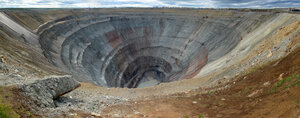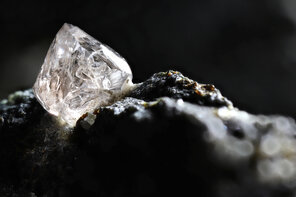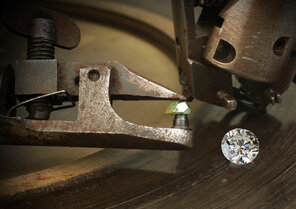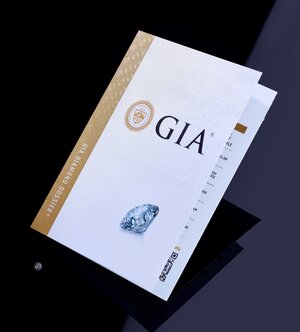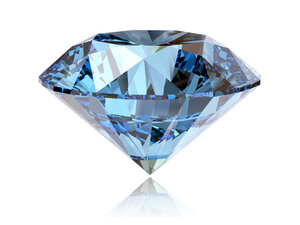The „Birth“
The diamond is not only the hardest, but also the oldest gemstone. It consists of chemically pure carbon, which crystallised under high heat ( 2000°C) and enormous pressure (70,000 kg/cm²). The formation process began about 3 billion years ago & took place in the earth's interior at a depth of 150 to 200 km. The diamondiferous rock reached the earth's surface through volcanic eruptions.
The two types of deposits
In the primary mine, the diamond-bearing source rock is mined within the volcanic vent. The secondary deposits are located within rivers and on seashores. Over thousands of years, erosion has eroded the volcanoes and transported the diamonds via river water.
Secondary
The simplest method, which is also used by independent diamond prospectors, the "diggers", is washing out the river debris. Rock containing diamonds was carried away from the actual volcanic vent by watercourses. In the past, the rough diamond was washed out by hand with primitive pans, but today it is washed out and removed from the rivers and seashores with elaborate machines.
The degradation
- The beginning of all discoveries was chance
- With the beginning of the 20th century, mining companies systematically develop diamond deposit
The deposits
- Today, diamonds are found in twenty countries
- Although geologists continue to strive to open up new deposits, only one in two hundred deposits develops into a profitable enterprise
- It takes 200-250 tonnes of rock, stone or sand to find a 1 carat diamond
- 80% of all diamonds found do not meet the high standards required to be processed into jewellery stones. They end up in industry, where they are just as sought after for technical applications due to their exceptional hardness.
The rough stone
- The uncut, raw diamond crystal often looks so similar to a pebble that most people cannot distinguish it at first glance
- The ideal shape of the crystal is the octahedron (double pyramid with 8 triangular faces)
- The actual shape of the rough diamond determines how and in which cut form the diamond can be further processed
- From the rough stone to ultimately the cut & polished diamond, the stone loses an average of 54% of its weight
The processing
Only the art of cutting and polishing brings out the full beauty of the diamond. The perfect cut enables the optimal use of light and thus gives it its unique brilliance and fire. In order to work on a diamond - due to its unique hardness - again only diamond dust can be used. In the past, it took 4 to 8 hours just to saw through a rough stone of 1 carat. Today, lasers are used for this. The entire processing can take days or months. The cut determines the path of light in a diamond. The aim is to achieve the highest possible refraction of light.
We have specialised in the colours D-G (Top Wesselton) and the purity VS and SI.
Our delivery time is usually 1-2 working days.
Oval cut
- The symmetrical, elongated rounded shape is a popular alternative to the classic round cut
- Oval diamonds look larger compared to roughly round diamonds of the same carat weight. In addition, this shape is particularly advantageous for short fingers.
Marquise cut
- Also known as navette, has a pointed base and end
- When choosing a diamond, they should pay special attention to the clarity and colour of the navette shape.
Teardrop cut
- The "pear cut" resembles a glittering drop. Diamonds in the teardrop cut have always been a popular choice for engagement rings. Unlike the round or oval cut, they are asymmetrical and therefore a little more special.
- The hue of the diamond is very visible, especially at the pointed end. Therefore, when choosing one, look for a shade at the upper end of the scale.
Radiant cut
- An angular diamond shape that achieves high brilliance through numerous facets
- Unlike the princess cut, it belongs to the step cuts and therefore shines with fewer facets in comparison
- Radiant-cut diamonds are not only available in a square shape, but also in an elongated rectangular shape
Princess cut
- This is an angular diamond shape that differs from the radiant cut in the arrangement of the facets
- Its square shape with the typical 57 or 76 facets gives diamonds in this shape a breathtaking sparkle. A great side effect: the many facets of this cut conceal small impurities inside the diamond.
Emerald cut
- Called an "emerald cut" in English. This is one of the most elegant cuts and belongs to the group of step cuts. In contrast to the brilliant cut, it has fewer but larger facets.
- Because of its relatively large table (the top, largest facet), it is recommended to look for particularly high clarity (e.g. VVS, VS1) when choosing a diamond in this cut
- Emerald cut diamonds look enormously noble & elegant and are absolutely timeless
Baguette cut
- Baguette cut diamonds are about two to three times as long as they are wide
- Viewed from above, their shape typically corresponds to an exact rectangle
- The few, large facets of the baguette cut make these diamonds sparkle less than round diamonds, for example
- However, hardly any other shape appears as luxurious and noble as this cut
Diamonds are suitable as a means of securing value, but not or only to a very limited extent as a means of increasing one's wealth in the short term. Pure value protection has received more and more attention in recent years. By buying an investment diamond, one can hedge one's assets well against inflation or possible crises. They are usually a tax-neutral investment and do not attract capital gains tax.
Flawless brilliant-cut diamonds in fine white and high-fine white with a very good cut from 0.50 ct to 2 ct are best suited for value protection. The larger the brilliant-cut diamonds, the more positive the value development. The resale of a larger stone is, however, more difficult.
If you have any questions about investment diamonds, we will be happy to advise you personally.
Why do I need a certificate when buying a diamond?
- The task and aim of the laboratories is to give buyers of a certified diamond the certainty that the diamond is actually of the quality for which you have paid
- The diamond is examined by a team of gemologists or diamond appraisers according to criteria that are defined worldwide
What do I have to consider when buying a certified diamond?
- A certificate is an independent, neutral and professional evaluation of a diamond, which proves the quality and thus also the value of the diamond and thus also objectively ensures the value in case of resale
- For this reason, we only offer diamonds with certificates from certification institutes that enjoy the highest recognition
These are:
Gemological Institute of America (GIA)
- GIA was founded in 1931 and is today the best known and most respected institute in the world
- This institute produces precise appraisals and interprets the valuation criteria most strictly
- Diamonds with a GIA certificate therefore have the greatest stability of value. For this reason, when buying, it should be noted that diamonds that have been awarded with this organisation usually fetch the highest prices.
Hooge Raad voor Diamant (HRD)
- Diamonds with certificates from HRD, are widely used, especially in Europe
- The certificates of HRD, a certification institute based in Antwerp, are highly recognised because they are accurate and strict in the evaluation of diamonds
- The institute is more or less the European equivalent of GIA
- Compared to GIA, HRD tends to rate slightly more strictly in the upper range of the colour scale and slightly less strictly in the lower range. HRD diamonds are therefore somewhat cheaper.
International Institute of Gemology (IGI)
- The institute with its headquarters in Anwerpen is one of the oldest and largest certification bodies worldwide
- IGI certificates can be assumed to value diamonds higher than GIA or HRD - this means that in borderline cases, they tend to choose the better valuation
- This is the reason why IGI stones are sometimes cheaper
How do I know if the diamond and the certificate belong together?
The diamonds have a laser inscription in the diamond's roundel. This is only visible under 20x magnification with a trained eye. However, the inscription clearly assigns the respective certificate to the diamond.
Among the white diamonds, the colours D - G are most in demand. When the colour concentration is low due to the influence of nature, diamonds have less value. Only as soon as there is a high percentage of colour in the diamond again, they are popular again and there is an increase in value. This is the case with the colour scale for diamonds when the colour is thinner than the Z colour.
The so-called fancy diamonds, where the colours in the diamond are all of natural origin, are traded in unbelievably high prices. Especially the pink diamonds fetch the highest prices. This is because pink and blue diamonds are very rare. Even of the ruby diamonds, only over 10 carats are known in the world.
In our colour treated diamonds, the colour is integrated into the diamond through an identical imitation of the natural conditions. The technique used for this is called HPHT (High Pressure, High Temperature). Incidentally, this is the same technique that is used for the production of artificial diamonds.
The colored diamonds that occur in nature are formed by the following addition next to the pure carbon:
- Yellow and brown diamonds: These colors also have a high percentage of nitrogen in the diamond.
- Blue diamonds: In blue diamonds, there is an additional high amount of boron in the diamond.
- Black diamonds: In black diamonds, there is an additional high percentage of graphite present.
- Pink diamonds: The color is created by a plastic deformation of the carbon atoms.
